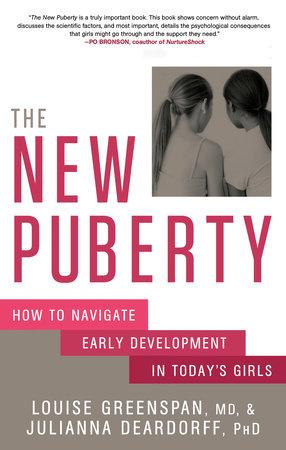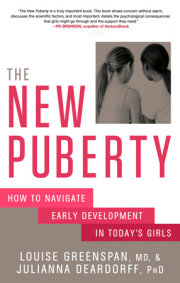CHAPTER ONE
MOVE OVER, JUDY BLUME
How We Define Puberty Today
TAKE A MOMENT TO CAST your mind back to the days of your puberty. Can you remember the first signs? How about when your body started to change in ways that made you feel awkward? Did you wish puberty had occurred sooner, later, moved faster, or perhaps taken longer? Most of us hardly remember the nuances of the transition we made long ago unless it was a traumatic one. Women might be able to reminisce vaguely about buying their first bra and deodorant, talking about crushes with their friends, and wondering when they'd get their first period. Men often recall the year they outgrew all of their clothing and shoes as they gained several inches in height, followed by a significant deepening of the pitch of their voice. But most of us don't have a detailed enough memory of the process our pubescent bodies went through to feel confident about how to advise our children on it--or to know how worried we should be--if they experience puberty at an early age, before they're 10 years old.
As doctors who have dedicated much of our lives to the study of adolescence and in particular to the science of early puberty, we talk all the time with confused adults who seem to feel so far removed from the pubertal process that it's as if they never experienced it themselves. Whether we're talking with parents or principals, child advocates or other medical professionals, we're constantly reassuring them that in a lot of ways, puberty is still very much the same. It's a rite of passage that everyone goes through, one that is marked by dramatic physical, neurodevelopmental, and emotional changes that forever shift our physiology, psychology, and behavior. It's that inevitable stage in our lives when we transition from childhood to adulthood through a gradually progressing phase we traditionally call adolescence.
And for girls, puberty is unique. It not only foments a complex array of emotional issues but also heralds the development of visual cues of sexuality (e.g., breasts, wider hips) to a degree that boys just don't experience. Now that we're seeing more girls going through puberty at younger and younger ages, though, parents and teachers must address a constellation of challenges sooner than most are ready for. One can hardly call a 7- or 8-year-old a preteen, much less an adolescent, but when puberty comes knocking on a girl's door at this tender age, we as a society are compelled to redefine what it means to grow up. Unbeknownst to her, she is also forcing scientists to revise medical texts.
That's exactly what makes today's puberty unlike that of generations past. The subtle but undeniable features of puberty--usually breast buds and pubic hair--are appearing earlier in contemporary girls than they did in typical girls growing up just a generation ago. And the dynamics related to this change have been altered as well. While you might recall upgrading your wardrobe to reflect trends in the juniors department at roughly the same time that you noticed boys and your body began to look and feel different, today's young girls are experiencing an extended interval between the start of physical development and the emotional maturity to even harbor thoughts of dating.
For centuries, coming-of-age stories have been a popular subject for authors, playwrights, and entertainers. From Shakespeare to Louisa May Alcott, writers have shared the pains of growing up through stories of vivid characters that readers can relate to. Judy Blume may have made today's grown women blush when they first read her novels in the 1970s and '80s, but today, the changed facts of puberty for many young girls call for a whole new series designed especially for 8- and 9-year-olds. And many young girls now are probably discovering authors like Judy Blume after they've already started puberty.
Until the 20th century, puberty tended to coincide with a girl's teenage years, as her body and brain developed relatively in sync. But over the past 100 years, and particularly in the past 2 decades, the trajectory of the body's development began changing--making the process of beginning puberty at age 7 or 8 highly unsettling for a girl and for her caregivers (from parents to teachers to even medical professionals). Today, the same girl who's playing with dolls is also shopping for bras and asking questions about body odor and hair. And the adults in these young girls' lives are asking us if they should be thinking of these girls as tweens at these very tender ages and letting them buy into the entire tween culture. Or do they continue to treat their girls like the children they actually are? No wonder so many people are confused and uncomfortable about dealing with this topic.
JUST WHAT IS PUBERTY?
As with many words that are used in both medical and lay circles, "puberty" is a loaded term. And further confusing its definition are the subtle differences among what's considered normal, early, and abnormal.
Contrary to popular belief, puberty in a girl doesn't commence with menstruation. Scientifically speaking, puberty reflects the beginning of hormonal secretions from the pituitary--an exceedingly complex gland deep in the brain--leading to physiological changes that include the "turning on" of the sex organs to the point where the individual can procreate. But this obviously doesn't happen overnight, and the process varies enormously from girl to girl. Puberty is actually difficult to study; while a girl's age when she gets her first period is a clear benchmark, other steps in the development of young bodies--especially the changes that occur early on-- are more gradual.
NEW PUBERTY FACT
A girl's first period doesn't signal the start of puberty. Puberty commences silently in the brain long before menstruation begins.
In other words, puberty is not like a single doorway to adulthood; instead, it's a long hallway. It's a process rather than a threshold. Every girl follows her own individual pathway. Some start with breast budding, while others sprout pubic hair first. In fact, the pubertal process happens twice in human development. In the womb, a girl's hormonal circuitry is first turned on and then turned off a few months after birth. We don't know the function of this "infant puberty," but we think it may prepare the endocrine (hormonal) system for reactivation in adolescence. Girls are born with their eggs in a sort of suspended animation in the ovaries until menarche.
From a scientific perspective, our understanding of puberty expanded over the past century, thanks to new technologies and pioneering doctors. During that same period, society changed dramatically as advances in medicine afforded us longer lives than any previous generation had. Once antibiotics and vaccines were introduced and our food supply multiplied thanks to the development of agricultural and manufacturing technologies, we grew taller and lived longer. Of course, greater access to foodstuffs and the rapid growth of the processed food industry also made for some unwanted outcomes, namely an escalating problem with overweight and obesity. Now the obesity epidemic has struck our children, too, and one of its manifestations appears to be the earlier onset of puberty, as we'll soon see.
Anyone who chronicles the subject of puberty usually starts the tale with the groundbreaking work in the 1940s of the late James M. Tanner, MD, an English pediatrician who is credited with creating modern standards for measuring a child's development. We still use his terminology in medicine today. Following Dr. Tanner's death at the age of 90 in 2010, Bruce Weber wrote about him for the New York Times in a beautiful essay that read like an ode: "Dr. Tanner was equal parts meticulous researcher and creative thinker whose interests lay where the fields of biology, psychology, and sociology intersect. He wrote widely, discussing, for instance, how the growth patterns of children can be powerful indicators of how their societies care for their young, and examining the connection between a child's physical and psychological development during adolescence." Weber went on to describe how, beginning in 1948, Tanner managed a study of childhood growth that the British government had commenced during World War II. Conducted among the residents of an orphanage in a small town north of London, it was supposed to record the effects of malnutrition on growth, but then progressed into a longitudinal study that involved photographing and measuring the same youths over several years.
Out of this pioneering study came a universal growth chart like those found in pediatricians' offices. But Tanner's chart, as Weber details, "expanded the range of growth patterns considered to be normal and led to the general understanding that neither early nor late maturation of a child is, on its own, an aberration." The study also established the now-famous Tanner stages--collectively, the Tanner scale--which define physical maturation as a sequence of bodily changes that occur during puberty. The stages are based on physical characteristics that one can see from a young girl's or boy's outer appearance: Girls are evaluated for breast development and the amount and length of pubic hair, whereas boys are similarly classified according to genital development and pubic hair growth. (Other signs, like voice change, the presence of facial hair, growth spurts, and even menstruation, are important physical milestones, but they're not the key measures when it comes to monitoring puberty.)
A girl in Tanner stage 1, for instance, is a preadolescent with no pubic hair whose breasts have not developed or changed since infancy. But a girl in Tanner stage 5, the last stage, has pubic hair that resembles that of an adult woman in quantity, type, and shape (the classic inverse triangle) and breasts that have fully developed. In this stage, there's a clear projection of the nipple, and the areola--the dark area surrounding the nipple--has receded a bit.
THE TANNER STAGES IN GIRLS
Tanner 1: No changes since infancy (no pubic hair, no breast buds)
Tanner 2: Breast budding, some pubic hair growth
Tanner 3: Further enlargement of breast tissue, progression in the distribution and color of pubic hair
Tanner 4: Increased breast size and elevation of the nipple area, adultlike pubic hair that doesn't reach the inner thighs
Tanner 5: Mature female breasts, adultlike pubic hair and distribution with extension onto the thighs
Tanner also blazed trails in the study of childhood growth beyond just formulating pubertal growth charts. For example, he was among the first to investigate administering growth hormone to children with growth disorders and other developmental problems. His research findings have been embraced worldwide and have even influenced other disciplines, including sociology and economics. Tanner was revered for his theoretical musings. He asserted that the average height of a child during a particular time period in history was largely a reflection of their nutritional status during that era and that a person's adult height was determined not only by their genes but also by the adequacy of their nutrition early in life.
Puberty, like adult stature, involves both genetic and environmental forces. On the individual level, the exact age at which a girl goes through puberty is based on a number of factors unique to her. But on a societal scale, the mean age at which girls as a whole go through puberty is largely determined by environmental factors. Your DNA doesn't change much once you're born. But your environment does. And the two interact to influence how girls grow and develop.
As we'll stress throughout the book, race (or ethnicity) does not determine the timing of puberty, but in our culture it is associated with it. Early puberty's higher prevalence among certain populations, particularly African Americans and Latinos, likely has less to do with the underlying genetics associated with a particular ethnicity and more to do with social and environmental issues. Unfortunately, the risk factors for early puberty, such as obesity, disproportionately affect poor and minority populations in the United States. Social inequality in America remains a huge challenge today, and it rears its ugly head every time statisticians run numbers to understand demographics and related health risks in certain populations. Particular racial and ethnic groups have greater challenges from factors in the environment, such as the presence of pollutants, poor access to healthful foods, and exposure to hormone-disrupting chemicals, that may interact with genes to initiate puberty earlier than in children from other neighborhoods. (More on this in Chapters 3 and 5.)
NEW PUBERTY FACT
Puberty involves both genetic and environmental forces. Early puberty's higher prevalence among certain populations likely has less to do with the underlying genetics associated with a particular ethnicity and more to do with social and environmental issues.
The idea that the environment plays a large role in early puberty (and in health in general for that matter, regardless of age) is one that deserves more attention in research circles. Even though genes encoded by DNA are essentially static (barring the occurrence of mutation), the expression of those genes can be highly dynamic in response to environmental influences. This field of study, called epigenetics, is now one of the hottest areas of research. We believe epigenetic forces affect us from our days in utero until the day we die. There are likely many windows during one's lifetime when we are sensitive to environmental impacts, and puberty in particular represents a time of great vulnerability to concrete influences like synthetic chemicals and to less tangible ones, such as a lack of stability in the home and socioeconomic conditions. The multitude of neural and hormonal actions that control pubertal onset are susceptible to disruption and adaptation, especially by environmental changes.
Epigenetics is the study of sections of your DNA (called marks or markers) that essentially tell your genes when and how strongly to express themselves. These epigenetic marks control not only your health and longevity, but also how you pass your genes on to future generations. Our day-to-day lifestyle choices are now believed to have a profound effect on the activity of our genes. And this is true whether you're a 7-year-old on puberty's threshold or a 70-year-old at risk for a heart attack.
Copyright © 2015 by Louise Greenspan, MD, and Julianna Deardorff, PhD. All rights reserved. No part of this excerpt may be reproduced or reprinted without permission in writing from the publisher.







